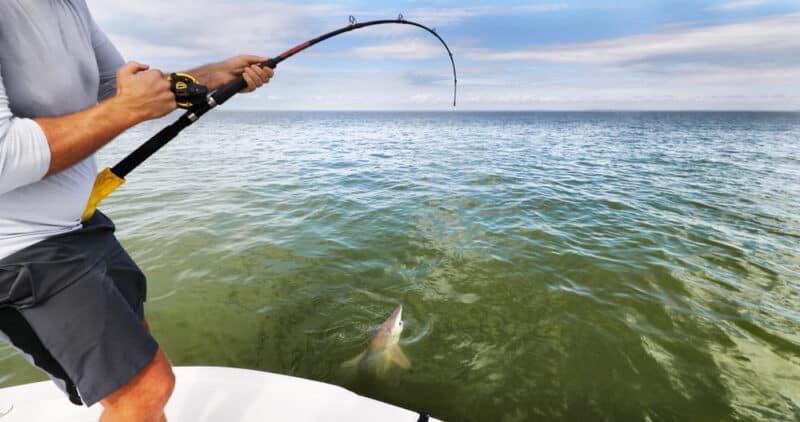What Type of Reel Should You Use for Shark Fishing?

Shark fishing is one of the most exciting forms of sport fishing there is. Someone who lives on a coastal area may have seen a shark fin slicing majestically through the water. For as long as people have known that there are fish in a body of water, they’ve wanted to pull those fish out.
Shark fishing is legal in every U.S. State that borders on an ocean or the Gulf of Mexico. The U.S. Government prohibits finning sharks or being in possession of shark fins while not being in possession of the corresponding sharks, but it does not restrict or prohibit shark fishing. Because shark fishing is free to pursue in the United States, different reels for shark fishing can be found everywhere.
What About Spincast Reels?
When talking about spincast reels and saltwater fishing, it’s only for the sake of having an example of what not to use. Spincast reels have a combination of characteristics that make them undesirable for saltwater fishing. They have a low line capacity, giving the angler minimal ability to let a shark or other large fish play out.
Being enclosed by the housing, a spincast reel also cannot lay the line back on the spool evenly. The narrow entrance to the housing also creates some sharp angles between the reel and the housing, promoting breakage when working a large, hard-fighting fish on the line like a shark, even if the reel can hold enough line. A spincasting reel is a fine option for casual weekend fishing on a lake, but for anything more involved, it should be left back in the garage for another day.
Of all spincast reels, only the 808 Saltwater by venerable spincaster specialist manufacturer Zebco, is built to take the rigors of saltwater fishing, and its 20-pound drag would make it technically capable of fighting even 100+-pound sharks. But with better options available to the shark fisher, the spincast reel should be avoided for shark fishing.
Here are some quick Shark Fishing tips!
Can I Use A Spinning Reel?
A spinning reel, like the kind you would find on a bass fishing rod, is the basic form of reel that one would use for beach fishing for sharks. Sharks that come in close enough to be within a cast from shore tend to be on the small side, and a heavy-duty spinning reel is a great way to start shark fishing without investing too much in new equipment.
The spinning reel is a versatile piece of equipment that is easy to maintain and easy to replace. A spinning reel will smoothly strip line from and return it to the spool, virtually avoiding line kinks and other problems that could result in a broken line and an escaped shark.
A heavy-duty spinning reel made of graphite or aircraft-grade aluminum will have great strength and light weight. Absolutely avoid a magnesium spinning reel if you are going anywhere near salt water, such as when chasing after sharks. For fighting sharks, low gear ratios are better than high, as you will need the additional cranking power far more than you will need fast retrieval speed. A spinning reel of 15 pounds’ drag capacity will handle small sharks, but for the most versatility, look for one of 20 to 25 pounds capacity.
It can be difficult to use a spinning reel to fish for sharks. But the difficulty is rewarded with one of the most engaging fights it’s possible to get from any game fish. The Penn Slammer III is the best-regarded spinning reel on the market, with a massive 30-lb. drag, a smooth, round handle, and the capacity to fight even the toughest monster that decides it wants to take a meal from you.
Let’s Talk About Baitcasting Reels
Baitcasting reels are the top choice of anglers who truly know what they’re doing. These heavy-duty reels have a spool that runs parallel to the rod rather than perpendicular to it as in a spincaster or a spinning rod. Baitcasters are not for everybody. There is a smooth learning curve from a spincasting reel to a spinning reel, but baitcasting reels, because they roll freely with the direction of the rod, can cause some difficulty if the fisher doesn’t know what they’re doing with the reel.
A baitcasting fisher should be careful with their casts, to avoid having their line fly off the real faster than the lure moves out into the water. The result can be a ratty “bird’s nest” of line that at best is difficult to untangle and at worst must be cut out. When fishing after shark, the versatility and power of the baitcasting reel is the first clear choice.
The best baitcasting reel available is the Okuma Maikara 2, a truly professional fishing weapon made of fine machined aluminum. This highly regarded reel can bring in even the largest and most powerful of game fish. With a slow reel uptake allowing it to fight the biggest fish with ease, the Maikara 2 is one of the best reels ever made for fishing big game, made by Taiwanese manufacturer Okuma. The difficulty with the Maikara 2’s slow reel uptake is that it will not be easy to pull in at the end of the day.
Reel Talk About Reels
Any successful shark fisher should have room for at least 300 yards (274 meters) of line on their reel. Any less than that and the shark will probably be able to run the angler out of line before they can be brought into the boat or onto shore or the dock. The line capacity in a spincasting reel, constrained by its enclosed spool, is just another in the cavalcade of reasons not to use a spincasting reel to fish for sharks. The shark fisher is better off using an open-spool reel like a baitcaster or a spinner rather than accept the limitations of a spincasting reel.
Last Chance Forever
Shark fishing can be fun and exciting. A shark is the most dangerous of all ocean hunters and because of that reputation, it has achieved the dubious immortality of humanity’s attention as a game fish. Many species of sharks are also endangered in the oceans because of people hunting them. Our descendants will only have the fun and excitement of fishing for sharks if we do our part to make sure that sharks continue to thrive for centuries to come.
You can also read:



